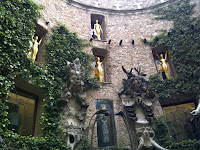
An in-class field trip brought us to Medieval Barcelona. On the way we passed the famous Palau de la Musica. I had walked by the building several times and always stopped to look at the architecture and why the older half and the newer half looked so different yet fit together so well like a puzzle. The facade of the Palau is magnificent, my favorite part being the huge glass panel at the entrance. From there we made our way around the corner to a smaller theatre known as L'Antic Teatre. I took the recommendation to return to L'Antic Teatre and have a drink on the patio. It was great. Directly next door to this smaller theatre we stopped as a class for about 10 minutes to discuss a building that was built in the 13th century. The building is the orange colored one picture below and to the right. As you can see the windows begin to get smaller and smaller as the floors get higher. This can be explained through an understanding of the class system in Medieval Barcelona. The walls that surrounded the city had prevented horizontal growth, thus it had to grow vertically. The owner of the building, thus the owner of the store or restaurant or whatever may be on the bottom floor, lived on the second floor and was


given the largest window. His floor was called 'Principal.' Today, in my apartment building in Barcelona, I press 3 when I use the elevator. However, before 3 there is Entresuelo, Principal, 1 and 2. I'm not sure what Entreseulo stands for or what it's historical significance, if any, it holds. After Principal, in Medieval Barcelona, lives the artisan or master of the craft who works in the store on the bottom level. After him are people who work for him and on top of them live the maids of the house and building. It is a social hierarchy of richest to poorest from the bottom up. Balconies were also a sign of affluence. We then made our way to Santa Maria del Mar and on the right there is a picture of a grave stone. Wealthy families


that donated money to the construction of the cathedral were given the privilege of burial within the cathedral itself. This field trip also focused on the many guilds of Barcelona and street names signified where members of the guilds lived and worked. A large plaza in Medieval Barcelona was Placa de la Llana. To the bottom and the left, there is a picture that shows the sign of the Llana guild, or textile workers. There are many markers like this around the old city. To the bottom and the right, another picture representing a separate guild dons the wall. These plaques on the walls have lasted 6 or 7 centuries and the history of the city can be unfolded by simply taking a walk.

 The weather has finally gotten nice enough to go to the beach and lay out in the sun. There's nothing better than after a day of classes heading to Barceloneta Beach, grabbing a sandwich and laying out in the sun. You just can't do that where I go to school in the Midwestern United States, unless laying out in the sun also means laying out in the cornfields. My favorite spot is near the W Hotel because I often find that its less crowded then it is closer to the clubs like Opium. One day I went to the beach and there was a sand castle competition going on. The picture to the right is by far the most clever sand 'castle' I have ever seen. I watch the artist construct the entire figure in less than thirty minutes and as soon as he was finished
The weather has finally gotten nice enough to go to the beach and lay out in the sun. There's nothing better than after a day of classes heading to Barceloneta Beach, grabbing a sandwich and laying out in the sun. You just can't do that where I go to school in the Midwestern United States, unless laying out in the sun also means laying out in the cornfields. My favorite spot is near the W Hotel because I often find that its less crowded then it is closer to the clubs like Opium. One day I went to the beach and there was a sand castle competition going on. The picture to the right is by far the most clever sand 'castle' I have ever seen. I watch the artist construct the entire figure in less than thirty minutes and as soon as he was finished  he began to instruct the Barca figure to the left. I through some change on the hand as I was about to leave and in the next five minutes, three police men came over to the hand and stepped all over it. I was so confused but it's apparently illegal to beg for money using sand 'castles.' The past few weeks in Barcelona have been great weather to relax at the beaches and I'm not looking forward to leaving and going back to Lake Michigan when I've been used to the Mediterranean Sea.
he began to instruct the Barca figure to the left. I through some change on the hand as I was about to leave and in the next five minutes, three police men came over to the hand and stepped all over it. I was so confused but it's apparently illegal to beg for money using sand 'castles.' The past few weeks in Barcelona have been great weather to relax at the beaches and I'm not looking forward to leaving and going back to Lake Michigan when I've been used to the Mediterranean Sea.








































